Many so-called “green” cleaning products hide harmful chemicals by using vague labels like “fragrance” or “trade secrets,” making it hard to know what’s really inside. Companies often emphasize eco-friendly claims without full transparency, while proprietary formulas block safety assessments. These products may look safe but often contain undisclosed chemicals that pose health and environmental risks. If you want to uncover the truth behind these labels, there’s more to learn about how to choose truly safe options.
Key Takeaways
- Many “green” cleaning products hide harmful chemicals under vague terms like “fragrance” or “water,” obscuring ingredient safety.
- Companies often use misleading labels or limited certifications to appear eco-friendly without meeting full sustainability standards.
- Proprietary formulas prevent full ingredient disclosure, making it difficult for consumers to assess health and environmental risks.
- Green claims may focus on a single eco-friendly feature while hiding less sustainable manufacturing practices or harmful additives.
- Lack of strict regulation allows companies to exploit loopholes, making it essential for consumers to scrutinize labels and seek trusted certifications.
The Marketing Myth of Eco-Friendly Labels
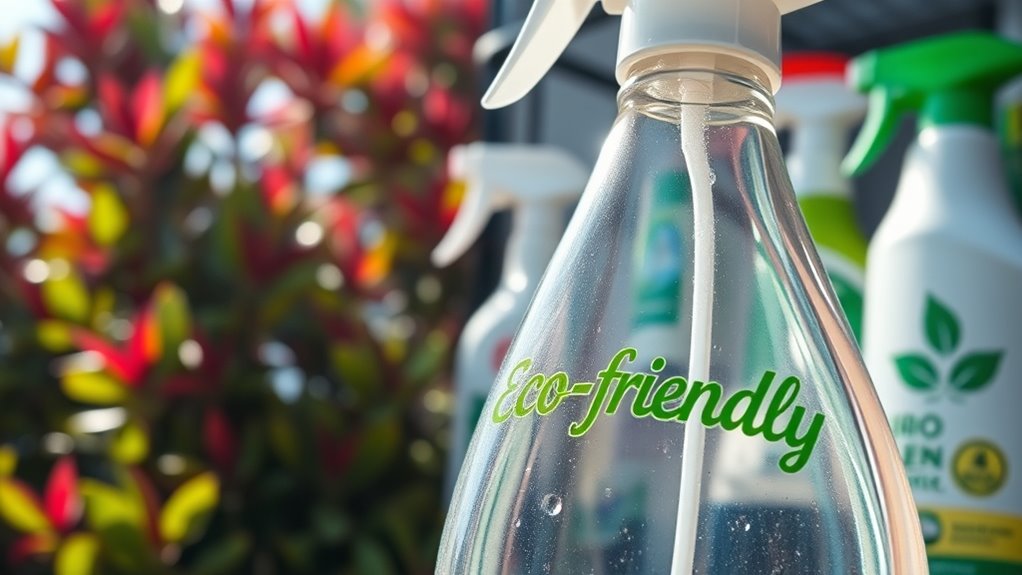
Many cleaning products boast eco-friendly labels, but these claims can be misleading. Companies often use vague or broad terms like “green” or “natural” to attract consumers, even when their products contain questionable ingredients. Labels may highlight a single eco-friendly feature, such as biodegradable packaging, while hiding less sustainable practices or harmful chemicals. Marketing strategies exploit your desire to make environmentally conscious choices, but they don’t always reflect the true impact of the product. You might assume that a product labeled as organic or eco-friendly is entirely safe and sustainable, but that’s not always the case. Always scrutinize the label, look for certifications, and research the brand’s transparency to make truly informed decisions. Don’t trust the marketing hype blindly—be a conscious consumer. Additionally, understanding the ingredients and their environmental footprint can help you avoid products that are marketed as eco-friendly but are not truly sustainable. Recognizing the sustainable practices involved in manufacturing can reveal hidden environmental costs that are not immediately apparent on the label. Being aware of environmental impact can also help you make more responsible choices beyond just the label claims. Recognizing the influence of scientific skepticism can also guide consumers toward more credible eco-friendly choices, rather than falling for marketing tactics.
Hidden Ingredients and Lack of Transparency
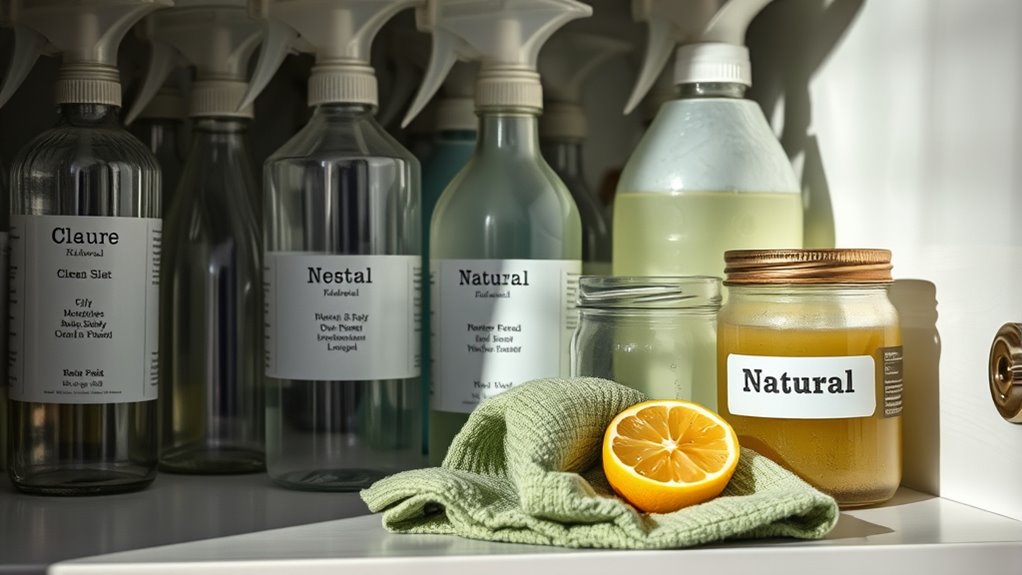
You might think green cleaning products are fully transparent, but many hide chemical components from you. Companies often keep proprietary formulas secret, making it hard to know what’s really inside. This lack of transparency can leave you questioning what you’re actually using in your home. Additionally, the absence of clear privacy policies regarding ingredient disclosure can contribute to consumer skepticism. Moreover, some products may contain outlandish antics or misleading claims that further obscure their true composition. The use of unregulated chemical ingredients can pose health risks that consumers are often unaware of. As the worth of some brands skyrockets, questions about their safety and honesty become even more pertinent. Without proper regulation and ingredient testing, consumers are left vulnerable to hidden dangers in these green cleaning solutions.
Unlisted Chemical Components
Despite claims of transparency, some green cleaning products hide certain chemical components from you. Manufacturers often list only vague terms like “fragrance” or “water,” leaving out specific ingredients that may be harmful or allergenic. These unlisted chemicals can include preservatives, surfactants, or solvents that aren’t required to be disclosed but could impact health or the environment. Without full disclosure, you can’t accurately assess the safety or eco-friendliness of a product. This lack of transparency makes it difficult to make informed choices and undermines trust. You might assume a product is truly green, only to discover hidden chemicals later. It’s essential to scrutinize labels carefully, ask questions, and prioritize brands that provide full ingredient transparency. Additionally, understanding the ingredients list can help identify potential risks and ensure you choose safer cleaning options. Being aware of vetted products can also guide you toward more trustworthy options that meet safety standards. Furthermore, awareness of home decor materials can help you select environmentally friendly and non-toxic household items. Recognizing regulatory standards can also aid in evaluating a product’s safety and environmental claims. Staying informed about industry disclosures can empower consumers to demand greater transparency from manufacturers.
Proprietary Formulation Secrets
Proprietary formulations allow manufacturers to keep certain ingredients secret, claiming it protects their intellectual property. While this might seem like a smart business move, it often leaves you in the dark about what’s actually in your cleaning products. Companies are not required to reveal all ingredients, especially when they’re considered trade secrets. As a result, you might be exposing yourself to chemicals you’d prefer to avoid, without even knowing it. This lack of transparency makes it difficult to assess the safety or environmental impact of these products. You rely on labels, but they can be intentionally vague or incomplete. Additionally, the 16PF traits associated with transparency and trustworthiness in organizations highlight how important honesty is in consumer products. Without clear ingredient disclosure, consumers cannot evaluate potential health risks, and this secrecy undermines trust. For example, some companies use proprietary formulas to hide ingredients that may cause allergic reactions or other health issues. Ultimately, proprietary formulas hide potential risks and prevent consumers from making fully informed choices about what they use in their homes.
Regulatory Transparency Gaps
Regulatory gaps often allow cleaning product manufacturers to withhold critical ingredient information, leaving consumers in the dark about what’s truly in their supplies. This lack of transparency can hide potentially harmful chemicals or undisclosed allergens. Here are four key issues:
- Ingredients often aren’t fully listed, thanks to loopholes in labeling laws.
- Fragrance formulas remain proprietary, hiding dozens of undisclosed chemicals.
- Regulatory agencies don’t always require disclosure of all ingredients, especially for “green” claims.
- Companies may exploit these gaps to avoid scrutiny of harmful substances.
As a consumer, you’re left guessing, unable to verify if products are truly safe or environmentally friendly. Without stricter regulations, transparency remains a significant challenge in understanding what’s really in your cleaning supplies.
The Reality Behind Certification Standards

While many consumers assume that certification labels guarantee a product’s safety and eco-friendliness, the reality is more complex. Certifications can be misleading or incomplete, often focusing on specific criteria while ignoring others. Companies may seek certifications that are easier to obtain or less strict, giving a false sense of trust. Additionally, understanding the Video Tutorial can help consumers better evaluate the quality and authenticity of product claims. Recognizing that emotional manipulation can influence perceptions of certifications highlights the importance of thorough research beyond labels. Being aware of certification standards can further enable consumers to make truly informed decisions, especially when considering the broader implications for career and professional development in making ethically responsible choices. Consumers should also consider the environmental impact of products beyond just the certification labels to ensure truly sustainable choices.
Dangerous Chemicals in Disguise

Many cleaning products labeled as “green” or “natural” can hide dangerous chemicals that aren’t immediately obvious. Companies often use vague terms or hidden ingredients to give a false sense of safety. Here are four chemicals you might unknowingly be exposed to:
Many so-called “green” cleaning products may still contain hidden, harmful chemicals.
- Phthalates – linked to hormone disruption and reproductive issues.
- Sodium Lauryl Sulfate (SLS) – can cause skin irritation and endocrine disruption.
- Fragrance – often contains dozens of undisclosed chemicals that may be toxic.
- Quaternary Ammonium Compounds – linked to respiratory problems and skin allergies. Incorporating regulatory frameworks can help better oversee these disclosures and ensure consumer safety.
Always read labels carefully, and don’t be fooled by “green” claims. These hidden chemicals can pose real health risks despite the natural appearance of the products. Understanding the impact of chemicals in household products can help you make safer choices for your family’s health.
Green Products With Questionable Effectiveness
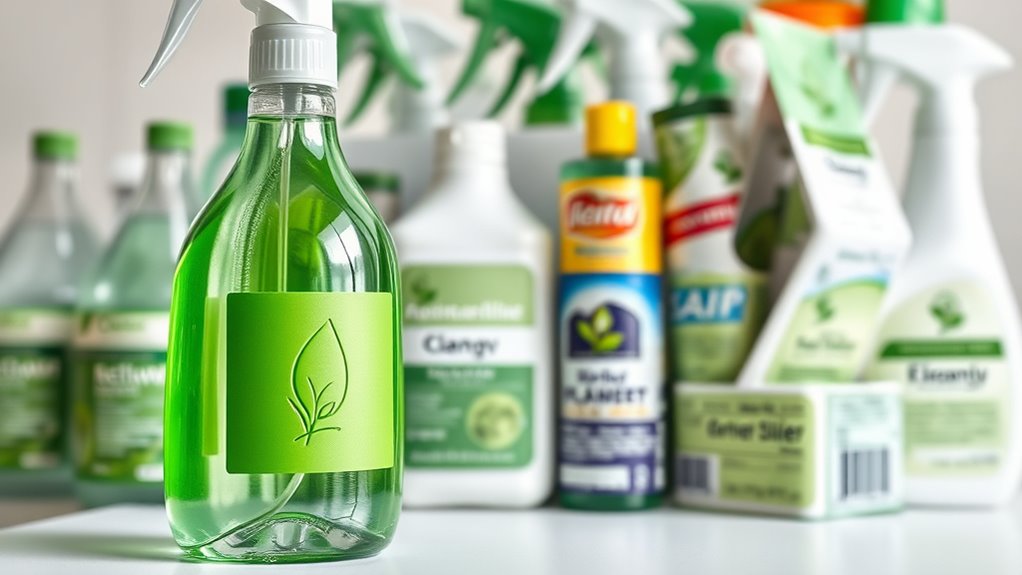
You might wonder if green cleaning products really work as well as conventional ones, since some lack solid proof of effectiveness. Many brands don’t clearly share their ingredients, making it hard to judge their performance. Additionally, regulatory compliance challenges can mean some products don’t meet safety standards or transparent labeling requirements. This lack of transparency can also make it difficult for consumers to assess the true quality and safety of these products. Ultimately, you need to ask if these products live up to their promises or just offer false hope.
Efficacy Doubts Persist
Despite the growing popularity of green cleaning products, questions about their effectiveness remain. Many consumers wonder if these products truly clean as well as traditional options. Here are four reasons why doubts persist:
- Limited Testing: Not all green products undergo rigorous testing to prove they kill germs or remove stains effectively.
- Vague Claims: Labels often make broad claims like “natural” or “eco-friendly” without specifying performance standards.
- Inconsistent Results: Users report varying results depending on the brand or application, raising questions about reliability.
- Short-Term Focus: Many green products excel at odor control or surface appearance but fall short on deep cleaning or disinfecting.
These factors make it clear that skepticism about their efficacy isn’t unfounded.
Ingredient Transparency Lacking
While green cleaning products often market themselves as safe and natural, their ingredient lists can be surprisingly opaque. Many companies avoid transparency, listing vague terms like “fragrance” or “biodegradable surfactants” instead of specific chemicals. This lack of detail makes it hard for you to assess what’s really inside the product and whether it’s safe for your family or the environment. Some ingredients may be synthetic or contain allergens, yet they’re hidden behind generic labels. Without clear disclosure, you’re left guessing about potential risks. This opacity undermines trust and prevents informed choices. You might think you’re buying a truly green product, but without transparency, you can’t be sure what you’re actually getting. Transparency isn’t just a marketing gimmick—it’s essential for your safety and confidence.
Performance vs. Promise
Many green cleaning products claim to be just as effective as conventional options, but their actual performance often falls short of their promises. You might notice that they struggle with tough stains, odors, or grime, leaving you frustrated. Here’s what to watch out for:
- Limited cleaning power—they may clean surface dirt but fail on grease or mold.
- Short-lived freshness—the scent might fade quickly, giving a false sense of cleanliness.
- Inconsistent results—performance can vary between batches or brands.
- False advertising—promises of disinfecting or deep cleaning often go unfulfilled.
Before switching, test green products thoroughly to see if they meet your expectations. Don’t rely solely on marketing claims.
The Impact of Manufacturing Practices
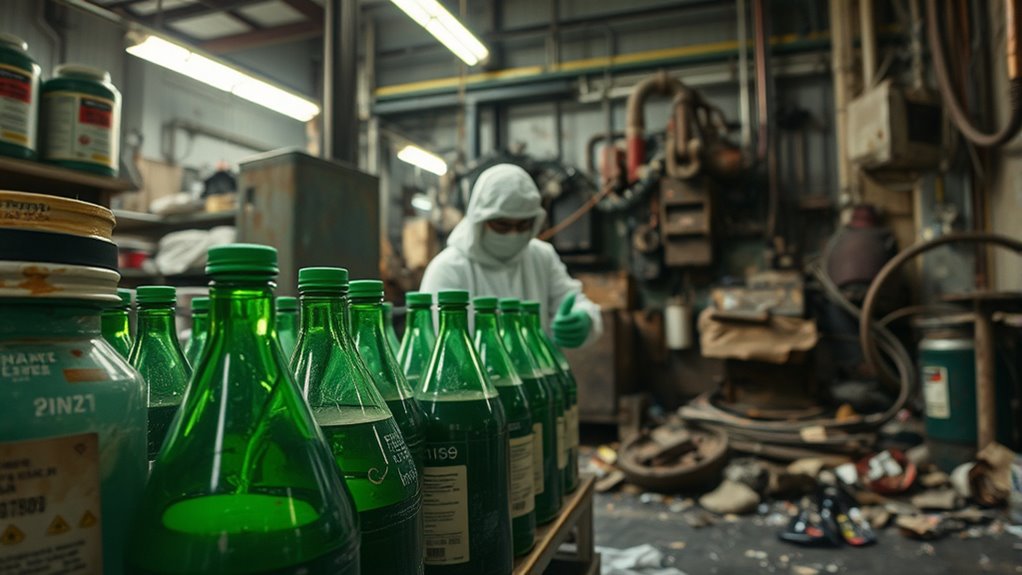
Manufacturing practices play a crucial role in determining whether a cleaning product is truly green. When companies prioritize eco-friendly methods, they reduce waste, lower energy consumption, and minimize harmful emissions. Sustainable manufacturing often involves sourcing raw materials responsibly and avoiding toxic chemicals during production. Conversely, some companies cut corners to save costs, leading to environmental damage and pollution. The chemicals used in manufacturing can also impact worker safety and local communities if proper safeguards aren’t in place. By examining how products are made, you can better assess their environmental footprint. Truly green products are made through transparent, responsible practices that prioritize ecological health and social responsibility. Your awareness of manufacturing impacts helps you make more informed, eco-conscious choices when selecting cleaning products.
How to Read Labels Like a Pro
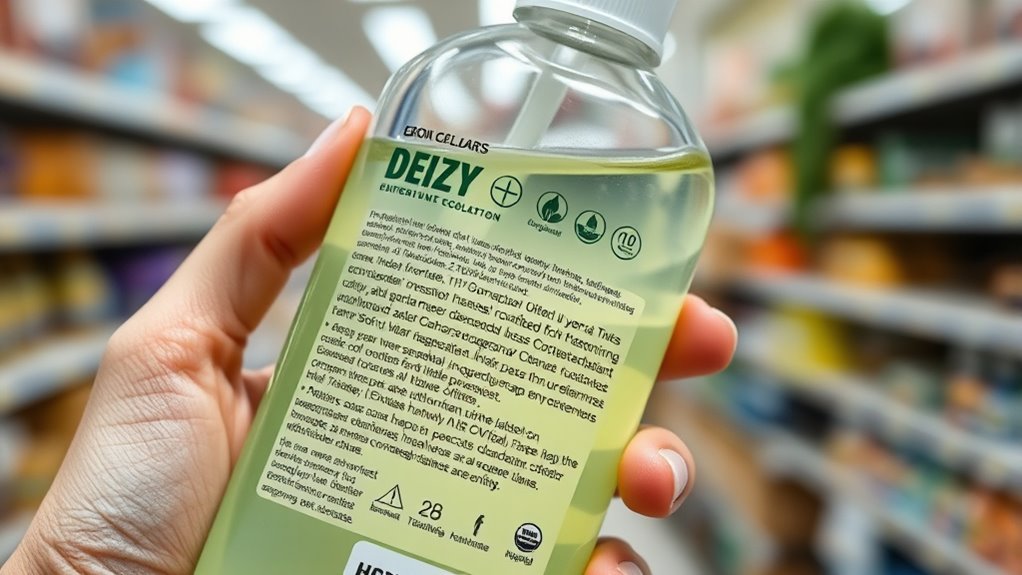
Reading labels on cleaning products is essential to guarantee you’re choosing truly green options. To do this effectively, focus on these key steps:
Always read cleaning product labels carefully to select truly eco-friendly options.
- Check ingredient lists – look for familiar, natural ingredients and avoid long chemical names.
- Identify certifications – trust labels like EcoLogo, Green Seal, or USDA Organic.
- Read the warnings – note any hazard symbols or caution statements indicating potential risks.
- Understand claims – scrutinize buzzwords like “biodegradable” or “non-toxic” and verify their meaning.
Safer Alternatives You Can Trust
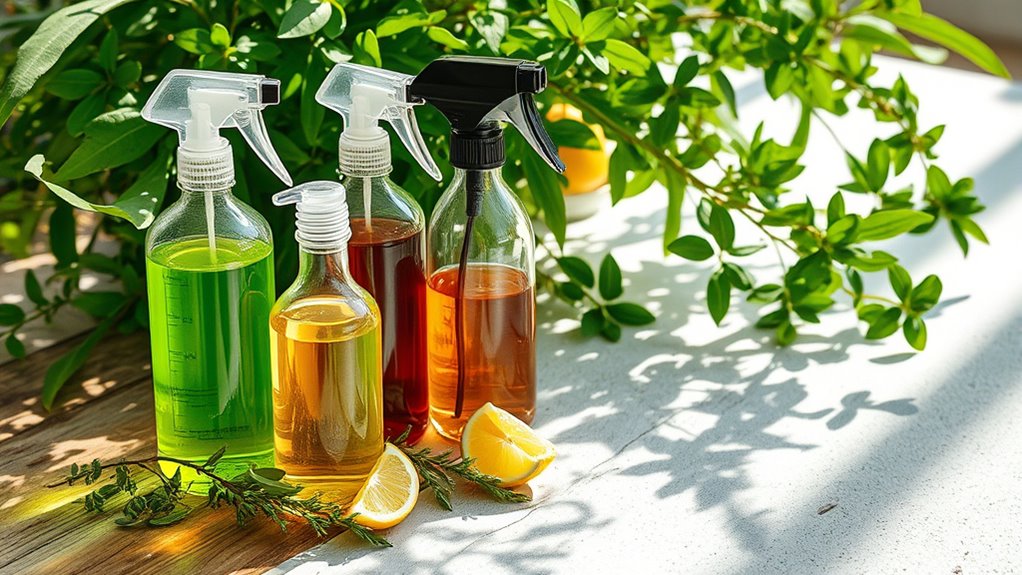
When choosing cleaning products you can trust, exploring safer alternatives is a smart move. Look for options with simple, recognizable ingredients like vinegar, baking soda, and lemon. These natural ingredients effectively clean without harmful chemicals. Many brands now offer plant-based or mineral-based products that are safer for your family and the environment. Always check labels for certifications such as EPA Safer Choice or USDA Organic to ensure transparency. Avoid ingredients like phthalates, artificial fragrances, and ammonia. Below is a quick guide:
| Ingredient | Safer Alternative | Benefit |
|---|---|---|
| Vinegar | Apple cider vinegar | Disinfects and deodorizes |
| Synthetic Fragrance | Essential oils | Natural scent and antimicrobial |
| Bleach | Hydrogen peroxide | Brightens and disinfects |
Choosing these alternatives helps protect your health while maintaining a clean home.
Making Informed Choices for a Healthier Home
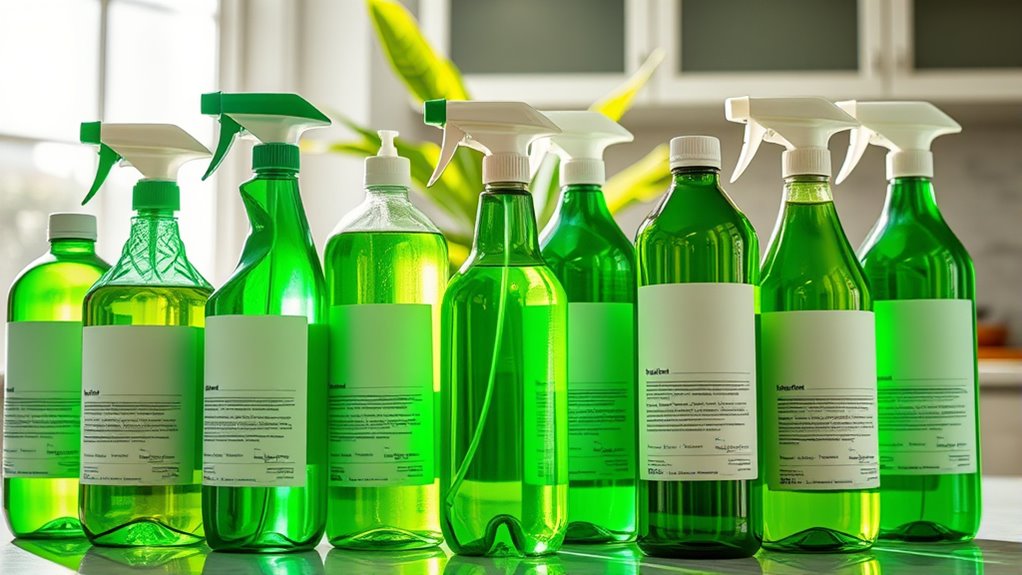
Making informed choices is essential to creating a healthier home, and that starts with understanding what’s in your cleaning products. To avoid harmful ingredients, consider these steps:
- Read labels carefully—look for transparent ingredient lists and avoid vague terms like “fragrance” or “trade secrets.”
- Research brands—choose companies committed to eco-friendly and non-toxic ingredients.
- Use simple, natural ingredients—baking soda, vinegar, and lemon can often replace commercial cleaners.
- Stay updated—follow trusted sources to learn about safe products and ingredient regulations.
Frequently Asked Questions
Are “Green” Cleaning Products Truly Safer for Children and Pets?
You wonder if “green” cleaning products are safer for children and pets. While they often contain fewer harsh chemicals, it is crucial to read labels carefully. Some products may still have ingredients that cause allergies or irritation. Always test a small area first, use them in well-ventilated spaces, and opt for products with transparent ingredient lists. Ultimately, natural does not always mean completely safe, so stay vigilant.
Do Natural Ingredients in Cleaning Products Always Mean Better Safety?
Did you know that 60% of consumers believe natural ingredients are automatically safer? When you see “natural” on cleaning products, it doesn’t always mean better safety. Some natural substances can cause allergies or irritate skin, especially for sensitive people or pets. So, instead of relying solely on labels, it’s best to check ingredient lists and do your research to make truly safe choices for your home.
How Do Green Labels Differ Across International Markets?
You’ll notice that green labels differ across international markets because standards vary widely. Some countries strictly define “green” or “eco-friendly,” requiring certifications and transparent ingredient lists. Others have looser regulations, allowing companies to use vague or misleading claims. As a consumer, you should scrutinize labels, research local standards, and look for trusted certifications like EcoLabel or USDA Organic to guarantee products meet genuine environmental and safety criteria.
Can Eco-Friendly Cleaning Products Still Harm the Environment?
Did you know that some eco-friendly cleaning products still release volatile organic compounds (VOCs)? While they’re marketed as safe, these chemicals can harm indoor air quality and contribute to environmental pollution. You should read labels carefully and look for certifications. Just because a product claims to be “green,” doesn’t mean it’s completely harmless. Always research and choose products with transparent ingredient lists to truly protect the environment.
Are There Any Long-Term Health Risks From Seemingly Safe Cleaners?
You might wonder if seemingly safe cleaners could pose long-term health risks. While many are labeled eco-friendly, some contain hidden chemicals that may cause issues over time, like respiratory problems or allergies. It’s wise to read labels carefully, avoid products with harsh chemicals, and opt for natural alternatives. Staying informed helps you protect your health and minimize potential long-term risks, even from products marketed as safe.
Conclusion
Just like a wolf in sheep’s clothing, many so-called “green” cleaners hide harmful ingredients behind eco-friendly labels. When you know what to look for and read labels carefully, you’re arming yourself with the truth—protecting your home and loved ones. Remember, making informed choices isn’t just about avoiding toxins; it’s about taking control. Trust your instincts, do your research, and choose safer options—because a healthier home starts with smarter decisions.









